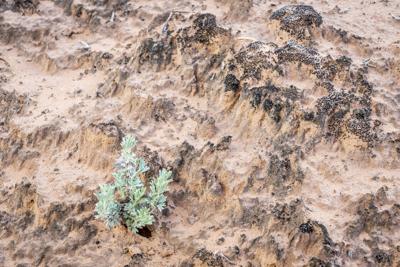If you've spent much time exploring Colorado, especially in the state's more desertic terrain, there's a good chance you've encountered an extremely fragile type of soil – and also a chance you've inadvertently destroyed a crucial process that won't recover for 1,000 years.
Described a knobby, blackish crust, cryptobiotic soil is a type of earth that contains living microorganisms and minuscule plant life. It's one of the oldest known living things on the planet, having played a role in restructuring the Earth's atmosphere and for its ongoing role in preventing early snowmelt.

Photo: National Park Service.
The soil is able to exist, in part, thanks to cyanobacteria, which helps to collect sunlight for nutrition. The cyanobacteria is also able to provide UV-protective pigmentation, which is why this biological soil tends to be darker than other soil in the area. While touching the soil is ill-advised as this can be damaging, the soil is also warmer than other soils due to how the darkening of the soil lowers the amount of sunlight that gets reflected, according to the National Park Service.
This cryptobiotic soil serves an important role in making harsh climates more hospitable to plant life, whether it's in desertic terrain or in places covered with volcanic ash.
On top of playing a crucial role in keeping the desert landscape alive, cryptobiotic soil also plays a role in snowmelt stability.
In years where dust is able to blow into Colorado's high-elevation mountains, typically seen in the form of a brownish-reddish coating on the snow, the snow absorbs more radiation, heating up and melting faster. According to a piece from High Country News, this can increase the likelihood of water shortages showing up later in the season. That being said, cryptobiotic soil is able to help keep this dust in place.
Unfortunately, this important living soil is also extremely easy to damage. A single footstep is able to impact the soil's functionality for 20-plus years in wetter climates and up to 1,000 years in more arid areas – like those found in western Colorado.
Cryptobiotic soil is yet another reason why it's so crucial to stay on designated trails while hiking around Colorado's terrain. And it's important to be able to identify this type of soil so that it can be avoided.
Per Leave No Trace, cryptobiotic soil is identifiable as "knobby, black crust," looking like "colonies of little dark colored towers on the desert floor." And if you step on it, there will be a crunch.
Given how important this soil is – both in terms of preventing early snowmelt and in terms of creating more hospitable terrain in harsh environments, do your part to Leave No Trace by staying on the trail and in designated areas in places where this soil exists.
Read more about the Leave No Trace principles here.









(1) comment
I hope these two idiots are identified and prosecuted to the highest degree. They are also teaching the girl that this is acceptable behavior. Contributing to the delinquency of a minor should be one of the charges.
Welcome to the discussion.
Log In
Keep it Clean. Please avoid obscene, vulgar, lewd, racist or sexually-oriented language.
PLEASE TURN OFF YOUR CAPS LOCK.
Don't Threaten. Threats of harming another person will not be tolerated.
Be Truthful. Don't knowingly lie about anyone or anything.
Be Nice. No racism, sexism or any sort of -ism that is degrading to another person.
Be Proactive. Use the 'Report' link on each comment to let us know of abusive posts.
Share with Us. We'd love to hear eyewitness accounts, the history behind an article.